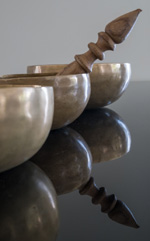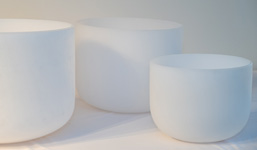Frequently Asked Questions
In a Gong Bath your body is ‘bathed’ in sound to encourage it to come back into balance and harmony in order to promote health and wellbeing.
You will lay down on a yoga mat, rest your head on your pillow, snuggle into your soft blanket and be given a few minutes to let go and start to relax. The instruments will be played for 45 – 50 minutes. During this time you become very relaxed and may even fall asleep! There will be a silence of a few minutes at the end to give you time to become more wakeful. Sue will tell you when it is time to sit up.
You can be provided with a chair if you give advance notice.
You need to bring your own yoga mat, pillow, blanket, eye mask (optional), tissues, and bottle of water. A rolled up towel placed under your knees is good for supporting backs! For 1:1 sessions a memory foam mattress topper, covered with a sanitised yoga mat, will be supplied for extra comfort.
No swimming costumes required! Wear comfortable, loose, clothing.
Each gong session will last one hour. In group sessions you will need to allow extra time before the session starts to settle and organise your yoga mat etc. You may need a little time after the session to check that you are grounded and fully ‘present’ before going home.
Clients have reported:
- A reduction of stress and anxiety levels
- Lower heart rate levels
- A sense of wellbeing and positive mood
- Increased energy levels
- The unlocking of emotions
- Reduced muscle tension
- Improved sleep quality
- Peace and tranquillity
- Pain relief
This is a time to relax and become more conscious of being present in the ‘here and now’. It can be helpful to focus on the senses and your physicality; observe and notice everything. Keep your eyes closed but aim to stay awake if possible. Be open to the experience rather than try to analyse it or anticipate what might happen. Every Gong Bath will be a unique experience; listen with child-like curiosity. Observe your thoughts and feelings/sensations as they arise without judgement – let them pass. There is nothing to remember or recall, if it is important is will come back to you after the gong bath. Enjoy being bathed in sound knowing that it is nurturing your body back into balance.
You will be advised to drink more water than usual and avoid alcohol. This will help to flush any toxins out of your system. Take some light exercise and nurture yourself. Detoxification may take place and this can be part of the healing process. The gongs may have brought things to the surface for you to acknowledge and deal with. This could be something physical, emotional, mental or spiritual. Be kind to yourself. If you have any questions or concerns Sue will answer by email or arrange a telephone conversation
Music results from the organisation of sounds into patterns, shapes and structures that are recognised and understood through training and/or experience. When listening to therapeutic instruments for the first time it can be difficult to let go of our tendency to need to make sense of the sounds we hear and categorise them. It is inevitable that previous musical experiences and associations may arise as we relate to the sounds. For example, one client recalled images of Buddhist Monks chanting and could see himself soaring over temples when he heard the Himalayan bowls. When the gongs are played some participants report hearing whale ‘song’ or alien sounds. When clients begin to experience sound for its own sake they move into a timeless, intuitive, way of being rather than the more usual time orientated, data processing and analytical response way of being.
Sound is energy we can hear; the transfer of sound waves from a vibrating object. Sound can be produced with the strike of a mallet, the scraping of a bow, plucking of a string, or a force of air producing a pressure wave. Sound travels as pressure waves that activate molecules to transfer the energy through a process of baton passing. A good way of understating it is to imagine people standing in a row each touching the person in front on the shoulder with their hands. When the person at the back of the queue is pushed each person is pushed in turn.
As sound travels it loses energy and weakens (decay). The distance it travels depends on the strength of the strike and the medium it is travelling through. It travels fastest through solids (fastest through steel) slower through liquid and slowest through gases. It radiates out in all directions – imagine a spherical starburst explosion from a firework (rocket).
When sound travels through the body it releases some of its energy. We hear it with our ears but we also feel the vibrations as the sounds travel through the tissues of our body. High sounds effect the surface layers and deep sounds penetrate right into the organs and bones. Lower sounds produce slower sound waves and take longer to move through the body; this is why we can feel vibrations. Sound that enter the ears is transmitted via the auditory nerve to the brain. However, the vagus nerve is connected to the posterior wall of the auditory canal and transmits sound waves to every major organ; this allows the brain to monitor and receive information relating to breathing, heart rate, blood pressure and digestion. When the vagus nerve is stimulated by the therapeutic instruments it helps to bring the body back into a state of relaxation by engaging the parasympathetic nervous system, ‘rest and digest state’.
As the gong session progresses brain waves slow down and move from a state of wakefulness (Beta) into a meditative state, an Altered State of Consciousness, where Alpha and Theta brainwaves predominate. Brain waves begin to lock into phase and synchronize with the sound waves produced by the instruments.
When Beta brainwaves predominate you feel awake and alert. When brainwave patterns slow and Alpha brainwaves predominate you feel relaxed and begin to daydream in a light meditative state. As brainwaves slow even further Theta levels are reached you enter a deep meditative state where dreams, visions, intuition and spiritual insight may occur. In this state you may bring up suppressed memories and emotions. Alpha and Theta are often referred to as trance-like states; an altered state of consciousness (ASC). If brainwaves slow even further Delta is reached you enter deep sleep.
These are all natural experiences that suggest that many areas of your brain have moved into a lower brainwave frequency such as Alpha (8-12Hz) or Theta (4-8 Hz) into an Altered State of Consciousness as the right hemisphere responds to the lower frequencies of sound provided by the gongs.
- Imagery: colours, patterns, scenes before closed eyes.
- Physical relaxation: muscles, relaxed, tension drains from the body, breathing is steady and relaxed.
- Loss of sense of time: the experience seems much shorter or longer than it actually takes. A sense of ‘now’, in the moment.
- Loss of sense of space: sensation of floating or sinking into the floor in a realm where there are no space boundaries and you ‘lose’ your edges – oceanic.
- Insight, clarity, understanding and intuition: recognition and/or solutions to predicaments, problems or issues in your life
- Positive mood: feelings of joy, elation, bliss, tranquillity and calm.
- A sense of unity: at one with everyone and everything. Everything is energy.
- Connection something sacred, profound or holy.
Although there is no direct evidence that the right hemisphere of the brain can become dominant it seems that aspects of increased right hemisphere activity are recognised during the dreamlike state of ASC. Here I would encourage you to read a book the brain scientist Jill Bolte Taylor in her book My Stroke of Insight, Hodder. She recalls her experience of recovering from a stroke which devastated the left hemisphere of her brain; her right hemisphere experience is fascinating. Each half of the brain controls specific functions, works very differently and complements each other. All the examples of ASC listed above reveal characteristics of right hemisphere activity. It is intuitive, visual, timeless, creative, imaginative and holistic. The rational left hemisphere is time orientated, sequential, communicates in language, describes and defines, is analytical, relates to past experiences, has a sense of isolation, identity and separateness, recognises boundaries and is judgemental.
The intuitive mind is a sacred gift and the rational mind is a faithful servant. We have created a society that honours the servant and has forgotten the gift.
Albert Einstein.
A gong is a suspended disc of metal. Chinese gongs are made of bronze (copper and tin). The Chao gong is very heavy and has a rim; the Feng gong is hammered almost flat with a shallow curve to the surface. They are first cast in a moulds, hammered into their final shape, tuned, polished and decorated. European gongs are made from Nickel Silver metal discs (an alloy of copper, nickel and zinc) called blanks that are hammered into their final shape before tuning, polishing and decorating. The surface of each gong is scraped with a specially designed chisel, to varying degrees. This opens up the sound to produce a more mellow sound. Finished gongs are polished and logos added.
Gongs are stuck with a soft headed mallets or sounds are gently teased out of the gong by drawing a Flumi (a rubber ball or silicone head on a stick) across the face of the gong. A wide variety of playing techniques are available to the experienced practitioner.
The sound of the gong is all encompassing, powerful, strong and very physical. It is often felt resonating in the body producing physical sensations. The gong can be relaxing (with a static drone and gently shaped waves of sound) or stimulating (when mallet strikes are stronger or played rapidly.)
When a gong is played by a skilled practitioner a complex sound structure is created as layer upon layer of tones and overtones/harmonics are generated to build a rich tapestry of sounds. The layers of sound become so complex sounds that the human brain is unable to analyse it. We ‘give in’ and submit ourselves to a landscape of sound that is often described as expansive, boundless, oceanic, and otherworldly.
 Handmade Himalayan Bowls and antique bowls are made of bronze (a mixture of copper and tin). The traditional way of producing bowls is to hammer them from a flat piece of metal; some are cast first, machine turned then hammered. Himalayan bowls can be played by striking the side of the bowl (described as ‘donging’) with a soft-headed mallet to produce bell-like sounds or by tracing the rim of the bowl with a wand to create long, sustained tones.
Handmade Himalayan Bowls and antique bowls are made of bronze (a mixture of copper and tin). The traditional way of producing bowls is to hammer them from a flat piece of metal; some are cast first, machine turned then hammered. Himalayan bowls can be played by striking the side of the bowl (described as ‘donging’) with a soft-headed mallet to produce bell-like sounds or by tracing the rim of the bowl with a wand to create long, sustained tones.
Wands come in different sizes and are made of different materials. Those covered with felt or suede to bring out the lower tones, those made of wood only are used to tease out the higher pitches (harmonics). The hard wood brings out the higher tones and soft wood, lower tones. A violin bow can be gently drawn across the rim to produce a brittle, thin, crystalline, icy sound. To produce a ‘wah-wah’ one of the smaller Himalayan Bowls is balanced on fingertips and a wooden wand is used to bring out a high-pitched sound. When the mouth is opened and closed close to the edge of the bowl a stimulating, energising and pulsing effect (wah-wah) is created.
The gentle ‘donging’ of the Himalayan bowls will draw your attention at the start of the session as you begin to settle. The long, pitched tones that follow promote a peaceful, gentle, calming, warm and soft atmosphere. The therapist will alternate soothing gentle tones with shorter sections focusing on stimulating higher tones. The sounds produced by the Himalayan Bowls are warm, nurturing, safe, soft, gentle and peaceful. Long, lower tones are deeply relaxing whereas the higher sounds bowls stimulate the system. Think of a massage that alternates soothing, smooth stretching sections with more intense work on knots and tight muscles. A return to the static, timeless sections have a stronger impact after stimulating the system; drifting off and letting go will follow naturally.
 Frosted Crystal Bowls are made by spinning clear quartz sand in a centrifugal mould; this is fused into a Crystal Bowl with an electric charge of 4,000 degrees. Bowls can be struck gently or sustained sounds are produced by tracing the rim of the bowl with silicone wands. Each bowl will produce a pure sine tone (no harmonics) of a specific pitch; differences in speed and pressure will affect the volume. Long, sustained individual pitches on the crystal bowls can last up to a few minutes at a time and encourage deep relaxation. Crystal Bowls can be played alternately (melodically) moving gradually from one pitch to the next, or played harmonically to produce two-note chords (dyads). The intervals (distances between pitches) will encourage specific effects carefully judged by the therapist.
Frosted Crystal Bowls are made by spinning clear quartz sand in a centrifugal mould; this is fused into a Crystal Bowl with an electric charge of 4,000 degrees. Bowls can be struck gently or sustained sounds are produced by tracing the rim of the bowl with silicone wands. Each bowl will produce a pure sine tone (no harmonics) of a specific pitch; differences in speed and pressure will affect the volume. Long, sustained individual pitches on the crystal bowls can last up to a few minutes at a time and encourage deep relaxation. Crystal Bowls can be played alternately (melodically) moving gradually from one pitch to the next, or played harmonically to produce two-note chords (dyads). The intervals (distances between pitches) will encourage specific effects carefully judged by the therapist.
Participants love the sound of the Crystal Bowls and often report experiences that indicate they have moved into Alpha and Theta brainwave activity (an Altered State of Consciousness) when listening to them.
Percussion instruments, such as shakers and rattles are played at the end of the gong bath. They have a primitive, edgy feel to them and they serve to stimulate the system to gently bring you back to a normal state of wakefulness. Sometimes they are used in the middle of a Gong Bath to vary the sound journey. This will serve to stimulate the system slightly before sinking back into relaxation.
The silence at the end of a gong bath is very important. It can be a very beautiful time and the silence following your sustained immersion in sound can be very profound. This ‘space’ allows your system to integrate the sounds it has experienced and gives you time to gradually become aware of external environmental sounds around you. Sue will speak once this time comes to an end and you will be encouraged to sit up and come back into a normal state of consciousness.
Please contact Sue to find out more or book an event or session.
You too could benefit from the kind of experiences described above.
